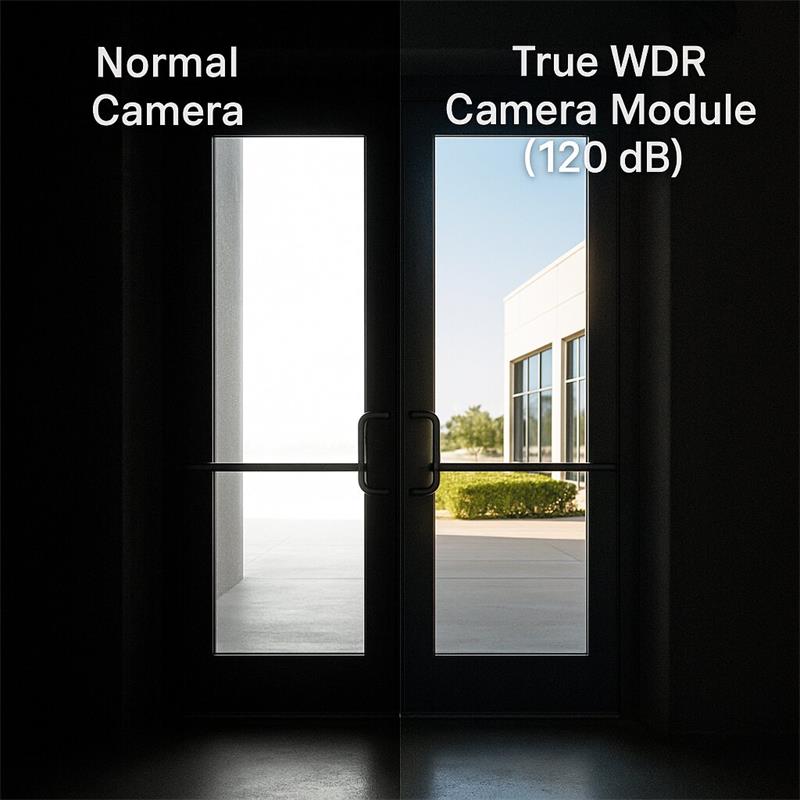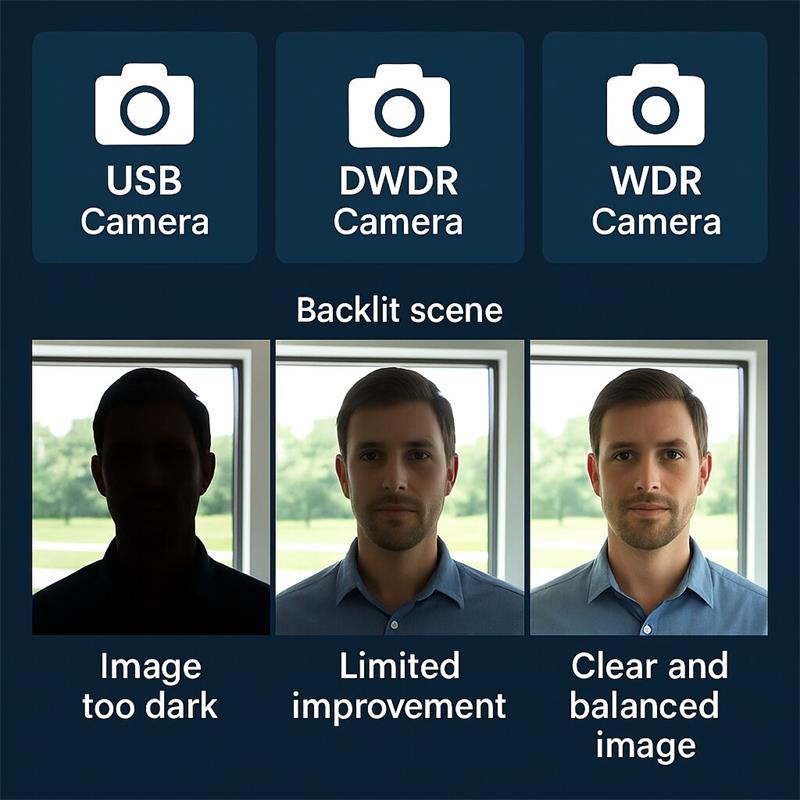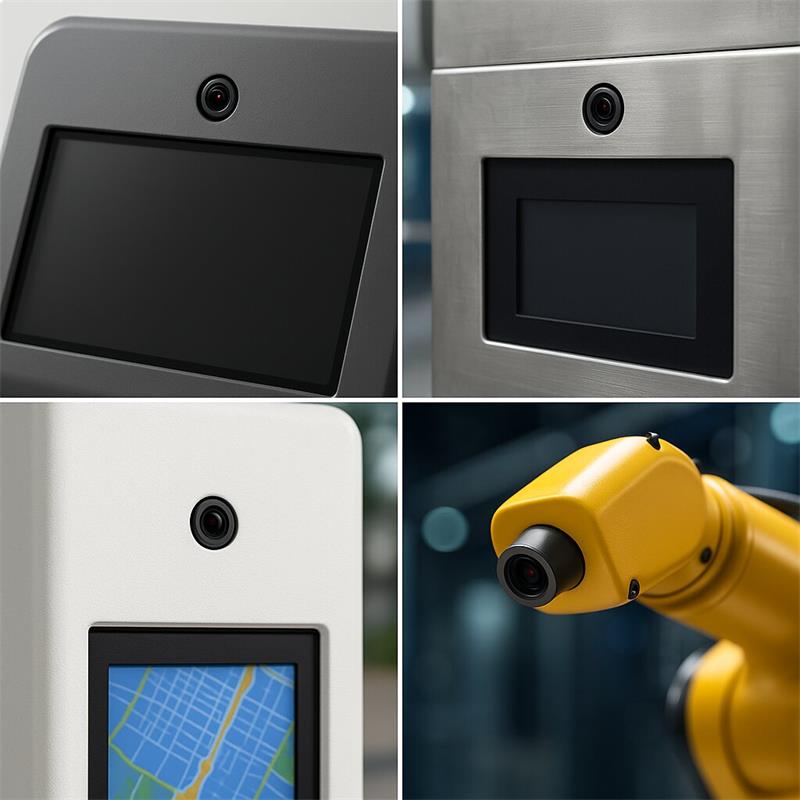
The Hook
Imagine this: You’ve just deployed a brand-new self-service kiosk in a high-traffic airport terminal. The software is state-of-the-art, the UI is smooth, but as soon as the morning sun pours through the glass facade, your kiosk camera can’t recognize IDs, faces, or QR codes. Transactions fail. Customers leave frustrated.
Or perhaps your robotic arm gripper camera in a factory stops mid-task because one side of the machine is brightly lit by welding sparks, while the other is in deep shadow.
If this sounds familiar, the problem isn’t necessarily your software — it’s the “eyes” of your system.
The Core Problem
Lighting in the real world is unpredictable and unforgiving. Standard cameras often fail in high-contrast environments where bright highlights and dark shadows coexist. They overexpose, underexpose, or lose critical detail. For engineers and product managers, this becomes the silent bottleneck that can derail entire AI vision and automation projects.
The Solution
The answer lies in True Wide Dynamic Range (WDR) technology. Unlike basic digital WDR, which relies on post-processing, true hardware WDR captures a much wider range of brightness in real time, preserving both light and shadow details.
The Promise
In this blog, we’ll explore why compact, high-performance WDR cameras — like the 15×15mm compact WDR USB camera — are the foundation for success across four mission-critical applications: Self-Service Kiosks, Smart Vending/Retail, Industrial Equipment Monitoring, and Edge AI Embedded Vision Nodes.

Think of True WDR like the human eye on steroids. Just as your pupils adjust seamlessly to peer into a dimly lit room while ignoring the blinding sunlight outside the window, WDR technology captures multiple exposures of the same scene in rapid succession—short for bright areas, longer for dark ones—and fuses them into a single, balanced image. This preserves intricate details across the entire dynamic range, from the darkest shadows to the brightest highlights.
The key distinction lies between True WDR (hardware-level) and Digital WDR (DWDR, software-level). True WDR, as in our true WDR camera module 120dB, operates at the sensor level, physically merging exposures for authentic, artifact-free results. It's ideal for high contrast imaging cameras where precision is non-negotiable. In contrast, DWDR relies on post-processing algorithms to tweak a single exposure, often introducing noise, ghosting, or lost details—fine for casual use but inadequate for professional setups like a facial recognition camera in varying light.
A critical metric here is the dynamic range rating, such as >100dB or our 120dB benchmark. For engineers, this quantifies the camera's ability to handle extreme contrasts—think a 120dB range means capturing details in scenes where the brightest part is over a trillion times brighter than the darkest, far surpassing human vision's ~100dB. This is crucial for low light WDR USB cameras that maintain clarity in challenging conditions.
To illustrate, consider a side-by-side comparison: On the left, a standard camera image of a backlit doorway shows the outdoor scene washed out and indoor figures lost in shadow. On the right, with True WDR enabled, every detail emerges—facial features, clothing textures, and background elements—all crisp and usable. (Insert image: WDR off vs. on in a high-contrast entrance scenario.)

In self-service kiosks, the battleground is unpredictable indoor-outdoor lighting. Hallways with glass facades flood devices with direct sunlight, causing glare on screens and documents, while spotlights create harsh shadows on users' faces. This leads to failed ID scans, QR code reads, or biometric verifications, frustrating customers and inflating error rates.
Our anti-glare USB camera module and camera for outdoor kiosk glare tackle this head-on. With True WDR, these modules—like the 15x15mm USB camera module—capture clear facial data regardless of backlighting, ensuring seamless integration into sleek kiosk designs. As an OEM USB camera module for kiosk, it fits snugly without compromising aesthetics.
The business payoff? Boosted transaction success rates by up to 30%, enhanced user satisfaction, and the flexibility to deploy kiosks in diverse locations—from sunny lobbies to dimly lit malls—driving higher ROI for system integrators and manufacturers.
The WDR Solution
A kiosk camera with true WDR delivers consistent imaging in such environments. Compact 15×15mm USB camera modules fit neatly into modern, slim kiosk designs. They serve as facial recognition cameras, ID scanners, and QR code readers without being affected by harsh backlight.
The Business Impact
Improved transaction success rates, enhanced customer satisfaction, and the ability to deploy kiosks in more locations — including bright atriums or outdoor kiosks with glare.

Smart vending machines and retail setups face dual lighting woes: Internal LED lights clashing with external ambient conditions, plus reflective glass doors that amplify glare. This hampers facial payment systems, age verification for restricted items (e.g., alcohol dispensers), and inventory tracking via visual AI.
A vending machine camera with True WDR, such as our low light WDR USB camera, excels here by delivering consistent images for accurate recognition. It enables reliable person detection in shadows and precise stock analysis through glass, all while being compact for space-constrained machines.
Commercially, this minimizes payment failures, enables trustworthy unmanned operations, and unlocks advanced AI features like customer behavior analytics, helping retailers scale efficiently and reduce operational losses.
The WDR Solution
A miniature USB camera with true WDR ensures clear imaging under mixed lighting. It becomes the ideal vending machine camera for tasks like facial recognition payments, age verification (e.g., alcohol sales), or inventory monitoring.
The Business Impact
Reliable autonomous retail operation, reduced payment errors, and improved capability to deploy AI-driven analytics.

Factories present a lighting nightmare: Dark machine crevices juxtaposed with brilliant welding arcs or overhead fluorescents. Standard cameras falter, missing defects in quality inspections or failing to monitor equipment gauges accurately, risking downtime and safety issues.
Enter our high contrast imaging camera solutions, like the true WDR camera module 120dB, which captures fine details on production lines even under extreme illumination. Its small form factor allows mounting inside machinery or on robotic arms, providing real-time data for automated optical inspection (AOI) and predictive maintenance.
The impact for industrial clients? Elevated detection accuracy, fewer false positives in monitoring, proactive equipment upkeep, and safer operations—ultimately slashing costs and boosting productivity in high-stakes environments.
The WDR Solution
A small form factor camera with WDR can be mounted directly inside equipment housings or onto robotic arms. As a high contrast imaging camera, it captures clear visuals of product surfaces, meters, and control panels even in mixed light.
The Business Impact
Better accuracy in Automated Optical Inspection (AOI), improved predictive maintenance, and safer operations. A rugged embedded camera for robots also enables 24/7 monitoring with minimal downtime.
At the edge, the mantra is "Garbage In, Garbage Out." Unreliable image inputs from varying light sabotage AI models on devices like drones or autonomous nodes, leading to erratic performance in computer vision tasks.
Our Jetson Nano compatible WDR camera and ROS compatible USB camera deliver pristine, consistent feeds via UVC camera module for smart terminal integration. This plug-and-play UVC compliance simplifies development on Linux/ROS platforms, ensuring high-quality data for edge processors without driver hassles.
For engineers and managers, this translates to more stable AI algorithms, reduced training iterations, faster time-to-market, and robust embedded systems that perform reliably in the field.
The WDR Solution
A low light WDR USB camera ensures reliable, clean, and consistent data streams for embedded AI models. Its UVC camera module for smart terminals works plug-and-play in Linux environments, with direct support in OpenCV, TensorFlow, and ROS.
The Business Impact
Shorter development cycles, higher model accuracy, and more reliable edge AI deployments. For system integrators, this means faster delivery and lower long-term costs.
Beyond core WDR capabilities, form factor is paramount. Our 15x15mm USB camera module redefines compactness, enabling integration into the tightest spaces—think slim kiosks or embedded nodes—without sacrificing performance, breaking free from bulky legacy designs.
Ease of integration shines with UVC standards: No custom drivers needed; it's instant compatibility with OpenCV in Python, C++, or other frameworks, accelerating prototyping for busy engineers.
Customization seals the deal for system integrators. We offer custom camera module design services, tailoring lenses for specific FOVs, cable lengths, and interfaces to match unique project specs—whether it's a specialized facial recognition camera or a rugged industrial setup.
Form Factor
The 15×15mm USB camera module is small enough to integrate into slim kiosks, compact vending machines, and embedded robotics.
Ease of Integration
As a UVC-compliant camera module, it requires no special drivers. Developers can start immediately in Python (OpenCV) or C++, and the module works out of the box with Jetson and ROS systems.
Customization
System integrators often need custom camera module designs — different fields of view (FOV), custom cables, or USB-C connectors. OEM flexibility ensures integration into diverse form factors, whether in kiosks, vending machines, or industrial panels.

Lighting challenges aren’t optional in the real world — they are inevitable. For engineers and product managers, the choice of imaging hardware often determines whether a project succeeds or fails.
Compact, industrial-grade, true WDR cameras are no longer a luxury — they are the foundation of reliable embedded vision.
✅ For engineers: “Ready to validate performance in your next project? Request our developer kit and start testing today.”
✅ For product managers: “Want to understand how our OEM WDR USB camera modules can elevate your kiosk or industrial solution? Contact our solutions team to discuss integration options.”